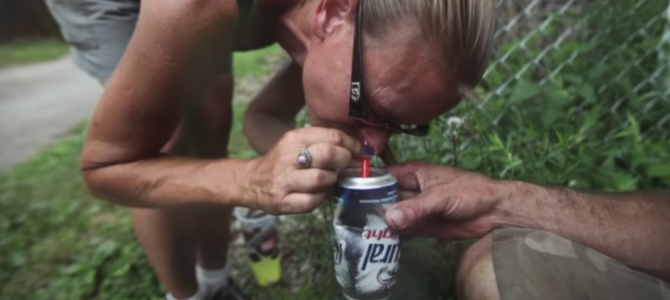
This article contains explicit content about illicit drugs.
A self-described “social justice” homeless shelter is using Seattle city funds to feed addicts’ deadly disease. Tax dollars are used to buy heroin pipes, syringes, and “booty bumping kits,” which allow users to rectally inject drugs for a more intense high.
The Downtown Emergency Service Center (DESC) operates several low-barrier shelters in Seattle. They serve the chronically homeless population, including those with addictions so severe they’ve stayed on the streets for, in some cases, years. Rather than offering a regimented, tough approach, DESC helps keep them addicted with what some claim is a harm-reduction strategy.
A homeless shelter uses Seattle city funds to feed an addicts deadly disease. Tax dollars are used to buy heroin pipes, syringes, and “booty bumping kits,” which allow users to rectally inject drugs for a more intense high. I discussed my exclusive on @TuckerCarlson Tonight. pic.twitter.com/QhbiK46ydp
— Jason Rantz on KTTH Radio (@jasonrantz) February 23, 2021
The city knows the addicts will in all likelihood continue their deadly addiction regardless of what case managers say or do. So DESC offers tools to be safer. Flyers adorn the walls of one of their locations encouraging two lower-risk alternatives to shooting up: smoking heroin and booty bumping.
One flyer notes staff are handing out heroin pipes (three kinds of glass!) to anyone who wants to try smoking heroin, rather than injecting it. “Smoking is a lower-risk alternative to injection. Give it a try!” the flyer enthusiastically endorses.
A second flyer promotes a free “booty bumping kit” as a “good choice if your veins are hard to hit.” Under this method, addicts use a needle-less syringe to inject a mixture of water and either meth or cocaine through their rectum. It offers “less risk of infection and abscesses” and promises that it “doesn’t leave tracks.” This isn’t a popular means of getting high; one need not spend too much time wondering why.
The number of tax dollars being wasted on this morally dubious strategy remains nebulous. The mayor’s office ignored requests for comment and Seattle’s Human Services Department offered little more than talking points explaining the strategy, ignoring direct questions on whether they endorse the flyers.
DESC Executive Director Daniel Malone, however, confirmed he’s using city funds for the heroin pipes and syringes. His approach is about the big picture.
“We try to reduce the stigma around substance use to encourage clients to share openly and honestly about their experiences and needs. We speak to clients frankly and directly about the risks and dangers of substance use and the options available to them about changing their use,” Malone told my Seattle-based talk radio show. “We have substance-use disorder counselor and opioid treatment nurse positions at the shelter who provide motivational interviewing, and individual and group counseling.”
It’s undoubtedly true that both of these methods can be safer than traditional intravenous drug use. It’s equally true that this behavior only delays an addict’s inevitable tragic death. Can one participate in “motivational interviewing” when he just booty bumped? Will an addict choose to go to counseling over a stop at the front desk for a new heroin pipe? Research seems to suggest this approach doesn’t work.
For all the promise of innovative and pragmatic approaches to addiction, the city of Seattle, and the programs it funds, have been abysmal failures. Homelessness isn’t just getting worse; addiction is too.
Last year, the region saw a surge in fentanyl and meth overdoses. With worsening heroin addiction (some 64 percent of the chronically homeless acknowledge they’re addicts), quality of life has deteriorated for Seattleites. Break-ins are common as addicts steal what they can, then sell the stolen property for cash to feed their habit. Taxpayers are fleeing. Software startup Syndio became the latest in a long-string of businesses to ditch Seattle over safety concerns.
“We want to stay in our city. We want to support the tech boom and growth, and support that community that is so robust and thriving in our city. But from a logistical place of business, it’s getting really tough to figure out where to be from a safety perspective,” CEO Maria Colacurcio said. “I’m struggling to figure out how to continue to be a part of this awesome tech community in the city of Seattle while balancing employee safety and figuring out where we can be.”
Parks are overrun with addicted homeless, some so violent and aggressive they’ve become a no-go zone for kids. At Miller Park, parents and youth sports coaches have been sounding the alarm for months.
“This year, with the way the field is, it’s unusable,” youth baseball coach Leo Lyons said. “Three of the four dugouts are occupied by [homeless] tents. If a foul ball goes over the backdrop and hits somebody in the head, what happens that way? And would you feel safe having your children here at this field right now?” The Seattle Youth Soccer Association has given up entirely, leaving the unsafe park.
What does Seattle have to show for this approach? Homeless addicts fall farther into addiction and the city has become more inhospitable to the public. The city is keeping addicts alive longer, so the harm they’re doing to themselves isn’t as quickly severe. But if they’re in a constant drug-induced stupor, languishing between hits off a heroin pipe or rectal injections of meth, are they truly living? Don’t we owe actual help to these people?









